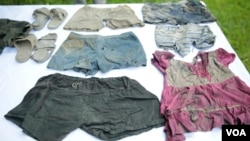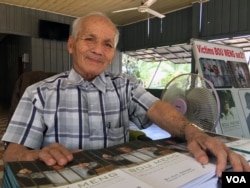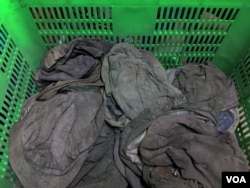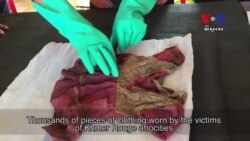During the 21 months he spent imprisoned in the secret Khmer Rouge prison code-named S-21, Bou Meng found a strange comfort in his prison uniform: black cotton shorts and sometimes, when he was lucky, a shirt.
“It was very cold at night, as I remember,” he told VOA Khmer in a recent interview. No blankets or any other personal items were given to prisoners, who spent most of their days and nights shackled to beds inside tiny rooms. Often they were released only to be tortured.
For Bou Meng, one of the few people to have survived the infamous jail, where some 14,000 people were confined and ultimately executed, the clothes still bring back vivid memories of those desperate months.
“They smelled very disgusting,” he said. When he was tortured, “they would strip my shirt off,” Bou Meng recalled. “My body was covered with blood.”
Large piles of pants and shirts similar to the ones that Bou Meng once wore, along with a jumble of hats, children’s clothes, shoes, belts, and other fragments of clothing, were part of the detritus left behind in the prison when the Khmer Rouge fled ahead of a Vietnamese invasion in January 1979. Many of them were grimy and stained with blood.
But while many of the more obvious artifacts of mass crimes—torture implements, shackles, documents—were immediately preserved in the genocide museum set up inside S-21 by the Vietnamese administrators who occupied Cambodia, the clothes were largely ignored.
Some were heaped up in a dusty pile while others were stuffed into black plastic bags, practically untouched for 40 years. Many of the garments began to deteriorate due to the effects of climate and haphazard handling.
Now, this is finally changing. Beginning late last month, the Tuol Sleng Genocide Museum, which is now administered by the Ministry of Culture, began a multi-year project to conserve 3,000 to 5,000 cloth artifacts, funded with a $55,000 grant from the U.S. government. For the first time, the clothes will be sorted, preserved, and, in some cases, displayed.
Julia Brennan, an American textile conservation expert spearheading the project, said the effort would employ cutting-edge technology to ensure that the clothes would be properly preserved without removing the dirt, sweat and blood stains that testify to their grim history.
“The dirt, stains, accretions, are a part of the genocide story and bear witness to the atrocities,” she said.
Brennan has also helped Rwanda’s National Commission for the Fight against Genocide preserve 45,000 cloth artifacts belonging to genocide victims there. She says clothes belonging to victims of mass crimes are unique, because in addition to their historical value they can be “forensic evidence” that may need to be analyzed in the future.
To this end, Brennan is working to set up a long-term storage system at Tuol Sleng Museum of Genocide using a new technology called DryStore, a plastic container with two built-in hygrometers that maintain a low relative humidity suitable for textiles.
DryStore was developed in 2012 by Rhino, a global technology provider for the agricultural industry based in Thailand, and relies on desiccant beads that absorb moisture and kill mold and insects. Until now, it has mainly been used for seed drying and storage.
In repurposing it for clothing conservation at S-21, Brennan has dubbed the technology a “heritage box,” and has used the U.S. grant money to purchase about 50 units for Tuol Sleng. Each can fit around 72 liters of textile artifacts.
The first step of the Tuol Sleng project, Brennan says, is to test this new “heritage box” system and develop a protocol that can be followed even after she leaves Cambodia.
“This storage system is efficient, low cost, and simple to use,” she said. If successful, it could be a breakthrough showing that the drying technology “can be applied everywhere for cultural heritage preservation, especially in humid climate,” she added.
The system will require regular monitoring to the temperature inside the storage room so that tiny adjustments can be made. Brennan is also helping install data-logging sensors in several rooms of the museum, to better track humidity and moisture levels and make sure that they are appropriate for textile artifacts.
“We have installed them in several locations of the museum so that Rh [relative humidity] and temp[erature] can be continually tracked, and provide long-range data through all seasons, day and night,” she explained. “This data is easily downloaded to the museum computer and read in charts. This can tell us if there is a time of day or year when the climate is more threatening to the collections—for example, during the monsoon.”
Every textile and article of clothing in the museum will also be photographed and documented, with a detailed description of its condition and description, before it is stored in the heritage box. This information will form the basis for a new computerized collection database that will be searchable by scholars, researchers, and survivors.
While refining the heritage box system, Brennan is also training a Cambodian cultural heritage conservator from the Tuol Sleng Genocide Museum, a textile conservator from the National Museum of Cambodia, and two archaeology students from the Royal University of Fine Arts about basic textile and preventative conservation and how to apply this technology to the S-21 collection.
One of the trainees, Chenda Ko, a conservator at the genocide museum, also recently attended a two-week program in cultural heritage conservation in Poland. She said only about 1,000 of Tuol Sleng’s cloth artifacts were in reasonably good condition. “The need for immediate preservation is now,” she said.
The textiles at S-21 had mostly been lumped together in black plastic bags before she spent several months organizing them by type of material. They have now been entirely sorted and are sitting in blue and red baskets, waiting to be documented and preserved in the heritage boxes.
Chenda Ko said the new drying boxes seemed like a promising and effective new technology, but she felt concerned about the size of the conservation facility. “It is too small” for so many artifacts, she said.
Still, no matter what form it takes, Bou Meng said the initiative was important to him—in part because it will allow future generations of Cambodians to see exactly what his prison garb looked like. Although they are long gone from his possession, he still remembers the black shorts that gave him a shred of comfort in the dark.
“They [the clothes] are a testimony to the genocide,” he said. “Younger generations are going to certainly benefit from it, so that they know what happened here.”













